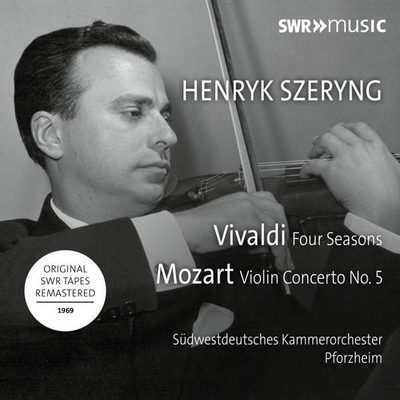Henryk Szeryng plays Vivaldi and Mozart

Artikelinfo
1969
2017
Antonio Vivaldi
Wolfgang Amadeus Mozart
Henryk Szeryng
Südwestdeutsches Kammerorchester Pforzheim
Antonio Vivaldi: Spring E major op. 8 No. 1 RV 269 (Der Frühling - from: Die vier Jahreszeiten op. 8)
Antonio Vivaldi: Summer g minor op. 8 No. 2 RV 315 (Der Sommer - from: Die vier Jahreszeiten op. 8)
Antonio Vivaldi: Autumn F major op. 8 No. 3 RV 293 (Der Herbst - from: Die vier Jahreszeiten op. 8)
Antonio Vivaldi: Winter f minor op. 8 No. 4 RV 297 (Der Winter - from: Die vier Jahreszeiten op. 8)
Wolfgang Amadeus Mozart: Concerto No. 5 A major K 219 for Violin and Orchestra
Henryk Szeryng was one of the great violinists of the 20th century In this album, he features both as violin soloist and conductor. Original SWR tapes, remastered Live concert recordings from December 7, 1969.
One of the great violinists of the twentieth century, Henryk Szeryng (1918–88) was an artist greatly celebrated during his lifetime, but is sadly known only to experts today. Looking back, his reputation may have been overshadowed by some of his contemporaries (Jascha Heifetz, Nathan Milstein, David Oistrakh, Yehudi Menuhin and Isaac Stern, for example), but in terms of his flawless technique and the power and beauty of his tone, Szeryng unquestionably remains one of the great masters of his era.
These two live concert recordings from December 7, 1969 feature performances by the South West German Chamber Orchestra Pforzheim. Szerying, as both soloist and conductor, stamps his natural authority on the music from the very first note, with his straightforward approach and clear sense of direction driving the entire ensemble. The soloist’s idiosyncratic nuances of tempo infect the whole structure, while his exuberant playing dominates the entire performance.
In Vivaldi’s ever-popular Four Seasons, Szeryng applies clear and often abrupt contrasts: heavy marcato, lively staccato, flawlessly balanced legato and, above all, his consummate tenuto, which seamlessly links every bow change. This last trait also thoroughly distinguishes his Mozart playing from almost anything to which our ears are accustomed today. When it comes to Mozart, we can admire the naturalness of his interpretation and his choice of tempi, which are not adopted merely for effect, but govern the logic and clarity of the articulation.